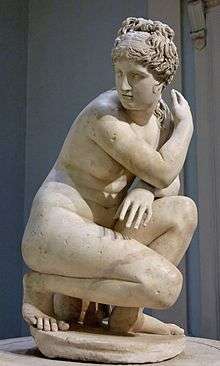Lely Venus
The Lely Venus is a marble statue of the crouching Venus type. It is a copy of a Hellenistic original by Doidalses of Bithynia and dates from the Antonine period.

History
The statue is first recorded in the Gonzaga collection in Mantua, where it was inventoried in the Gonzaga collection in 1627[1] Whilst there it was seen by the artist Rubens, who stayed with the Gonzaga family whilst on the continent on diplomatic and art-collecting duties for Charles I of England. It was an important influence on his voluptuous style of painting the female nude, so much so that it appeared at the National Gallery's "Rubens: A Master in the Making" exhibition from 26 October 2005 to 15 January 2006 [2]

It was soon purchased from the Gonzagas, in 1627–28, for Charles I of England,[3] It was remarked in England in 1631 as "the finest statue of all" and valued at 6000 ecus.[4] On the dispersal of Charles's art collections during the Commonwealth, it came into the possession of the painter and connoisseur Sir Peter Lely, from whom it derives its name.[5] Two years after Lely's death (1682), it was re-acquired from his collection for the Royal Collection. The statue was stolen from the Palace of Whitehall after it was destroyed by fire on January 4, 1698, and was recovered four years later by the Crown.[6][7]
Since 2005 it has been on long-term loan to British Museum, following treatment by their conservators, and is currently on display in gallery 23.[8]
Notes
- Published by Carlo d'Arco, Delle Arti e degli artefici di Mantova, II (1857), pp. 168–71, noted by A. H. Scott-Elliot, "The Statues from Mantua in the Collection of King Charles I" The Burlington Magazine 101 No. 675 (June 1959, pp. 214, 218–27) p 219f, note 18.
- Exhibition link Archived 2007-02-06 at the Wayback Machine and Image of it in the exhibition (Royal Collections report, page 4) Archived 2007-09-30 at the Wayback Machine.
- Alessandro Luzio, La Galleria dei Gonzaga venduta all'Inghilterra nel 1627-28 (1913), noted by Scott-Elliot 1959:220 note 19.
- "une figure de femme accroupie de marbre, aucuns disent Venus delli Eli, autres Hélène de Troye, c'est la plus belle statue de tous estimée à 6 mille escus": (a marble figure of a crouching woman, called by some the Venus of Elis, by others Helen of Troy, it is the finest statue of all, and is valued at 6000 Ecus) in the letter of the French agent Daniel Nys to Lord Dorchester, 13 June 1631; Scott-Elliot 1959:220; Haskell and Penny 1981:321
- In the Commonwealth Sale Inventory it is lot 10, £600, with the annotation bought by Lilly the Painter with Severall other his Mats. rarities. (A. H. Scott-Elliot, The Statues from Mantua in the Collection of King Charles I, The Burlington Magazine, Vol. 101, No. 675 (Jun., 1959), pp. 214, 218-227)
- Cornelius C. Vermeule Notes on a New Edition of Michaelis: Ancient Marbles in Great Britain, American Journal of Archaeology, Vol. 59, No. 2 (Apr., 1955), pp. 129-150
- British Museum (1966). Report of the Trustees. Trustees of the British Museum.
- BM page Archived 2012-09-13 at Archive.today
- Paul F. Norton, The Lost Sleeping Cupid of Michelangelo, The Art Bulletin, Vol. 39, No. 4 (Dec., 1957), pp. 251–257
- Anne H. van Buren, Erica Cruikshank Dodd, Ellen N. Davis, Clifford M. Brown, Letters to the Editor, The Art Bulletin, Vol. 57, No. 3 (Sep., 1975), pp. 466–467